Mechanisms for Enhancing Luminescence Yield in KBr Crystals under the Influence of Low-Temperature Uniaxial Elastic Deformation
Abstract
:1. Introduction
2. Materials and Methods
3. Results
3.1. X-ray Luminescence of Crystals KBr for Uniaxial Deformation in Directions <100> and <110>
3.2. Tunneling Luminescence of KBr Crystals under Uniaxial Deformation
3.3. Thermally Stimulated Luminescence of KBr Crystals under Uniaxial Deformation
4. Conclusions
Author Contributions
Funding
Informed Consent Statement
Data Availability Statement
Acknowledgments
Conflicts of Interest
References
- Hailey, C.; Craig, W.W.; Harrison, F.A.; Hong, J.; Mori, K.; Koglin, J.; Yu, H.T.; Ziock, K.P. Development of the Gaseous Antiparticle Spectrometer for Space-Based Antimatter Detection. Nucl. Instrum. Methods Phys. Res. Sect. B Beam Interact. Mater. At. 2003, 214, 122–125. [Google Scholar] [CrossRef]
- Froborg, F.; Duffy, A.R. Annual Modulation in Direct Dark Matter Searches. J. Phys. G Nucl. Part. Phys. 2020, 47, 094002. [Google Scholar] [CrossRef]
- COSINE-100 Collaboration; Adhikari, G.; Adhikari, P.; de Souza, E.B.; Carlin, N.; Choi, S.; Djamal, M.; Ezeribe, A.C.; Ha, C.; Hahn, I.S.; et al. Search for a Dark Matter-Induced Annual Modulation Signal in NaI(Tl) with the COSINE-100 Experiment. Phys. Rev. Lett. 2019, 123, 031302. [Google Scholar] [CrossRef] [PubMed]
- Baker, M.D.; Baker, A.D.; Hanusa, C.R.H.; Paltoo, K.; Danzig, E.; Belanger, J. Bonding in Sodium Chloride Nanotubes: A New Analysis via Madelung Constants and Cohesive Energies. J. Phys. Chem. C 2013, 117, 25742–25747. [Google Scholar] [CrossRef]
- Fernandez-Lima, F.A.; Henkes, A.V.; Da Silveira, E.F.; Nascimento, M.A.C. Alkali Halide Nanotubes: Structure and Stability. J. Phys. Chem. C 2012, 116, 4965–4969. [Google Scholar] [CrossRef] [PubMed]
- Sergeyev, D.M.; Shunkeyev, K.S. Investigation of Transport Parameters of Graphene-Based Nanostructures. Russ. Phys. J. 2018, 60, 1938–1945. [Google Scholar] [CrossRef]
- Sergeyev, D.; Shunkeyev, K.; Zhanturina, N.; Shunkeyev, S. The Influence of External Weak Magnetic Field on Anharmonic Nanocontacts of Josephson Type. IOP Conf. Ser. Mater. Sci. Eng. 2013, 49, 012049. [Google Scholar] [CrossRef]
- Song, K.S.; Williams, R.T. Introduction. In Self-Trapped Excitons; Springer Series in Solid-State Sciences; Springer: Berlin/Heidelberg, Germany, 1996; Volume 105, pp. 1–31. ISBN 978-3-540-60446-4. [Google Scholar]
- Lushchik, C. Chapter 8: Creation of Frenkel Defect Pairs by Excitons in Alkali Halides. In Physics of Radiation Effects in Crystals; Johnson, R., Orlov, A., Eds.; Elsevier: Amsterdam, The Netherlands, 1986; ISBN 978-0-444-59822-6. [Google Scholar]
- Lushchik, C.; Lushchik, A. Evolution of Anion and Cation Excitons in Alkali Halide Crystals. Phys. Solid State 2018, 60, 1487–1505. [Google Scholar] [CrossRef]
- Miyazaki, K.; Nakauchi, D.; Kato, T.; Kawaguchi, N.; Yanagida, T. Development of Tl-Doped KI Single Crystal Scintillators. Radiat. Phys. Chem. 2023, 207, 110820. [Google Scholar] [CrossRef]
- Miyazaki, K.; Nakauchi, D.; Kato, T.; Kawaguchi, N.; Yanagida, T. Tl-Concentration Dependence of Photoluminescence and Scintillation Properties in Tl-Doped RbI Single Crystals. J. Mater. Sci. Mater. Electron. 2022, 33, 22162–22168. [Google Scholar] [CrossRef]
- Shunkeyev, K.; Tilep, A.; Sagimbayeva, S.; Lushchik, A.; Ubaev, Z.; Myasnikova, L.; Zhanturina, N.; Aimaganbetova, Z. The Enhancement of Exciton-like Luminescence in KCl Single Crystals under Local and Uniaxial Elastic Lattice Deformation. Nucl. Instrum. Methods Phys. Res. Sect. B Beam Interact. Mater. At. 2022, 528, 20–26. [Google Scholar] [CrossRef]
- Shunkeyev, K.; Tilep, A.; Sagimbayeva, S.; Ubaev, Z.; Lushchik, A. The Effect of Instability of KCl:Na Single Crystals. Crystals 2023, 13, 364. [Google Scholar] [CrossRef]
- Okada, G.; Motoki, S.; Sakamoto, M.; Kusano, E.; Yada, R.; Fujimoto, Y.; Yanagida, T.; Nanto, H. Characterization of Optically-Stimulated Luminescence Properties by NaCl:Eu2+ Crystal and the Thermal Response. J. Alloys Compd. 2021, 863, 158561. [Google Scholar] [CrossRef]
- Shunkeyev, K.; Myasnikova, L.; Barmina, A.; Zhanturina, N.; Sagimbaeva, S.; Aimaganbetova, Z.; Sergeyev, D. The Thermostimulated Luminescence of Radiation Defects in KCl, KBr and KI Crystals at Elastic and Plastic Deformation. J. Phys. Conf. Ser. 2017, 830, 012138. [Google Scholar] [CrossRef]
- Gektin, A.; Belsky, A.; Vasiukov, S. Luminescence Properties of CsI:Eu Crystals. Opt. Mater. 2012, 34, 2017–2020. [Google Scholar] [CrossRef]
- Shunkeyev, K.; Lushchik, A.; Sagimbayeva, S.; Ubaev, Z.; Tilep, A. Exciton-Like Luminescence in a KBr Crystal Exposed to Uniaxial Elastic Deformation. Nucl. Instrum. Methods Phys. Res. Sect. B Beam Interact. Mater. At. 2024, 547, 165194. [Google Scholar] [CrossRef]
- Iwai, S.; Tokizaki, T.; Nakamura, A.; Tanimura, K.; Itoh, N.; Shluger, A. One-Center Small Polarons as Short-Lived Precursors in Self-Trapping Processes of Holes and Electron-Hole Pairs in Alkali Iodides. Phys. Rev. Lett. 1996, 76, 1691–1694. [Google Scholar] [CrossRef]
- Shunkeyev, K.; Maratova, A.; Myasnikova, L.; Sagimbayeva, S.; Zhanturina, N. The Specificity Intrinsic Luminescence of a CsI Crystal under the Influence of Low-Temperature Elastic Deformation. Nucl. Instrum. Methods Phys. Res. Sect. B Beam Interact. Mater. At. 2021, 509, 1–6. [Google Scholar] [CrossRef]
- Shunkeyev, K.S.; Zhanturina, N.N.; Aimaganbetova, Z.K.; Barmina, A.A.; Myasnikova, L.N.; Sagymbaeva, S.Z.; Sergeyev, D.M. The Specifics of Radiative Annihilation of Self-Trapped Excitons in a KI–Tl Crystal under Low-Temperature Deformation. Low Temp. Phys. 2016, 42, 580–583. [Google Scholar] [CrossRef]
- Kohzuki, Y.; Ohgaku, T. Deformation Luminescence of X-Ray-Irradiated KCl:Eu2+ Single Crystals by Compression. J. Lumin. 2023, 253, 119469. [Google Scholar] [CrossRef]
- Ramirez, M.; Bausa, L.; Biernacki, S.W.; Kaminska, A.; Suchocki, A.; Grinberg, M. Influence of Hydrostatic Pressure on Radiative Transition Probability of the Intrashell 4f Transitions in Yb3+ Ions in Lithium Niobate Crystals. Phys. Rev. B 2005, 72, 224104. [Google Scholar] [CrossRef]
- Grinberg, M. Excited States Dynamics under High Pressure in Lanthanide-Doped Solids. J. Lumin. 2011, 131, 433–437. [Google Scholar] [CrossRef]
- Mahlik, S.; Malinowski, M.; Grinberg, M. High Pressure and Time Resolved Luminescence Spectra of Gd3Ga5O12:Pr3+ Crystal. Opt. Mater. 2011, 33, 1525–1529. [Google Scholar] [CrossRef]
- Zhang, W.; Oganov, A.R.; Goncharov, A.F.; Zhu, Q.; Boulfelfel, S.E.; Lyakhov, A.O.; Stavrou, E.; Somayazulu, M.; Prakapenka, V.B.; Konôpková, Z. Unexpected Stable Stoichiometries of Sodium Chlorides. Science 2013, 342, 1502–1505. [Google Scholar] [CrossRef] [PubMed]
- Shunkeyev, K.; Lushchik, A.; Myasnikova, L.; Sagimbaeva, S.; Ubaev, Z.; Aimaganbetova, Z. Deformation-Stimulated Ex Luminescence in a RbI Single Crystal. Low Temp. Phys. 2019, 45, 1127–1130. [Google Scholar] [CrossRef]
- Kumar, V.; Luo, Z. A Review on X-Ray Excited Emission Decay Dynamics in Inorganic Scintillator Materials. Photonics 2021, 8, 71. [Google Scholar] [CrossRef]
- Dietrich, H.B.; Purdy, A.E.; Murray, R.B.; Williams, R.T. Kinetics of Self-Trapped Holes in Alkali-Halide Crystals: Experiments in NaI(Tl) and KI(Tl). Phys. Rev. B 1973, 8, 5894–5901. [Google Scholar] [CrossRef]
- Ianakiev, K.D.; Alexandrov, B.S.; Littlewood, P.B.; Browne, M.C. Temperature Behavior of NaI (Tl) Scintillation Detectors. Nucl. Instrum. Methods Phys. Res. Sect. A Accel. Spectrometers Detect. Assoc. Equip. 2009, 607, 432–438. [Google Scholar] [CrossRef]
- Sakai, T.; Koshimizu, M.; Fujimoto, Y.; Nakauchi, D.; Yanagida, T.; Asai, K. Luminescence and Scintillation Properties of Tl- and In-Doped CsCl Crystals. Jpn. J. Appl. Phys. 2017, 56, 062601. [Google Scholar] [CrossRef]
- Salas-Juárez, C.J.; Ugalde-Valdés, M.A.; Guzmán-Mendoza, J.; Nolasco-Altamirano, D.; Martínez-Gil, M.; Gómez-Dominguez, C.E.; Guarin, C.A.; Melendrez, R.; Rivera-Montalvo, T. Persistent Luminescence of Commercial TLD-100 Dosimeter: Using Shallow Traps for Radiation Dosimetry. Radiat. Meas. 2023, 167, 106997. [Google Scholar] [CrossRef]
- Sinclair, S.; Pech-Canul, M.I. Development Feasibility of TLD Phosphors and Thermoluminescent Composite Materials for Potential Applications in Dosimetry: A Review. Chem. Eng. J. 2022, 443, 136522. [Google Scholar] [CrossRef]
- Takizawa, Y.; Kamada, K.; Yoshino, M.; Kim, K.J.; Kutsuzawa, N.; Yamaji, A.; Kurosawa, S.; Yokota, Y.; Sato, H.; Toyoda, S.; et al. Growth of Thallium-Doped CsI/CsCl/KCl Eutectics and Their Scintillation Properties. Opt. Mater. X 2022, 15, 100159. [Google Scholar] [CrossRef]
- Rodriguez-Lazcano, Y.; Correcher, V.; Garcia-Guinea, J. Luminescence Emission of Natural NaCl. Radiat. Phys. Chem. 2012, 81, 126–130. [Google Scholar] [CrossRef]
- Muhamad Azim, M.K.; Abdul Sani, S.F.; Daar, E.; Khandaker, M.U.; Almugren, K.S.; Alkallas, F.H.; Bradley, D.A. Luminescence Properties of Natural Dead Sea Salt Pellet Dosimetry upon Thermal Stimulation. Radiat. Phys. Chem. 2020, 176, 108964. [Google Scholar] [CrossRef]
- Horowitz, Y.S. Thermoluminescence and Thermoluminescent Dosimetry; CRC Press: Boca Raton, FL, USA, 2020; ISBN 978-0-429-29228-6. [Google Scholar]
- Postawa, Z.; Kolodziej, J.; Baran, G.; Czuba, P.; Piatkowski, P.; Szymonski, M.; Plavina, I.; Popov, A. ESD of Nonthermal Halogen Atoms from In-Doped (001) KBr. Nucl. Instrum. Methods Phys. Res. Sect. B Beam Interact. Mater. At. 1995, 100, 228–231. [Google Scholar] [CrossRef]
- Plavina, I.; Popov, A.I.; Tale, A. Photostimulated Luminescence of KBr-in Crystals. Radiat. Eff. Defects Solids 1995, 135, 125–128. [Google Scholar] [CrossRef]
- Khoshakhlagh, M.; Islamian, J.P.; Abedi, S.M.; Mahmoudian, B. Development of Scintillators in Nuclear Medicine. World J. Nucl. Med. 2015, 14, 156–159. [Google Scholar] [CrossRef] [PubMed]
- Watanabe, K.; Kawabata, Y.; Yamazaki, A.; Uritani, A.; Iguchi, T.; Fukuda, K.; Yanagida, T. Development of an Optical Fiber Type Detector Using a Eu:LiCaAlF6 Scintillator for Neutron Monitoring in Boron Neutron Capture Therapy. Nucl. Instrum. Methods Phys. Res. Sect. A Accel. Spectrometers Detect. Assoc. Equip. 2015, 802, 1–4. [Google Scholar] [CrossRef]
- Miyazaki, K.; Nakauchi, D.; Kato, T.; Kawaguchi, N.; Yanagida, T. Suppression of Afterglow in RbI:Tl Scintillator by Co-Doping. J. Mater. Sci. Mater. Electron. 2023, 34, 1082. [Google Scholar] [CrossRef]
- Myasnikova, L.; Shunkeyev, K.; Zhanturina, N.; Ubaev, Z.; Barmina, A.; Sagimbaeva, S.; Aimaganbetova, Z. Luminescence of Self-Trapped Excitons in Alkali Halide Crystals at Low Temperature Uniaxial Deformation. Nucl. Instrum. Methods Phys. Res. Sect. B Beam Interact. Mater. At. 2020, 464, 95–99. [Google Scholar] [CrossRef]
- Bekeshev, A.; Shunkeyev, K.; Vasil’chenko, E.; Elango, A. Effect of Uniaxial Compression on the Luminescence of Self-Trapped Excitons in CsI at 80 K. Phys. Solid State 1997, 39, 75–76. [Google Scholar] [CrossRef]
- Pokorny, P.; Novotny, M.; Fara, J.; Dekhtyar, Y.; Lushchik, A.; Jaaniso, R.; Fitl, P.; Lancok, J. Bulk and Surface Processes in KBr Single Crystals Examined by Thermostimulated Luminescence and Exo-Electron Emission. Opt. Mater. 2021, 117, 111191. [Google Scholar] [CrossRef]
- Pokorny, P.; Novotny, M.; Dekhtyar, Y.; Lushchik, A.; Hruška, P.; Fara, J.; Fitl, P.; Musil, J.; Jaaniso, R.; Lancok, J. Surface Processes on KBr Single Crystals Examined by Thermostimulated Exo-Electron Emission and Desorption. Opt. Mater. 2021, 114, 110898. [Google Scholar] [CrossRef]
- Shunkeyev, K.; Sarmukhanov, E.; Bekeshev, A.; Sagimbaeva, S.; Bizhanova, K. The Cryostat for Deformation of Crystals at Low Temperatures. J. Phys. Conf. Ser. 2012, 400, 052032. [Google Scholar] [CrossRef]
- Mikihiko, I.; Shohei, W.; Tadanobu, K.; Masayasu, U. Intrinsic Luminescence of Alkali Chlorides and Bromides. J. Phys. Soc. Jpn. 1967, 23, 138–139. [Google Scholar] [CrossRef]
- Lynch, D.W.; Robinson, D.A. Study of the F′ Center in Several Alkali Halides. Phys. Rev. 1968, 174, 1050–1059. [Google Scholar] [CrossRef]
- Aboltin, D.E.; Grabovskis, V.J.; Kangro, A.R.; Lushchik, C.; O’Konnel-Bronin, A.A.; Vitol, I.K.; Zirap, V.E. Thermally Stimulated and Tunneling Luminescence and Frenkel Defect Recombination in KCl and KBr at 4.2 to 77 K. Phys. Status Solidi A 1978, 47, 667–675. [Google Scholar] [CrossRef]
- Grabovskis, V.J.; Vitols, I.K. Tunneling Recombination Luminescence in KBr and KCl. J. Lumin. 1979, 20, 337–342. [Google Scholar] [CrossRef]
- Elango, A.A.; Nurakhmetov, T.N. Structure and Generation Mechanism of Br Centres in X-Rayed KBr. Phys. Status Solidi B 1976, 78, 529–536. [Google Scholar] [CrossRef]
- Lushchik, A.; Lushchik, C.; Lushchik, N.; Frorip, A.; Nikiforova, O. Formation and Decay of Electronic Excitations Localized near Divacancies in Alkali Halides. Phys. Status Solidi B 1991, 168, 413–423. [Google Scholar] [CrossRef]
- Lushchik, A.; Kudrjavtseva, I.; Lushchik, C.; Vasil’chenko, E.; Kirm, M.; Martinson, I. Creation of Stable Frenkel Defects by Vacuum Uv Radiation in KBr Crystals under Conditions of Multiplication of Electronic Excitations. Phys. Rev. B 1995, 52, 10069–10072. [Google Scholar] [CrossRef] [PubMed]
- Delbecq, C.J.; Toyozawa, Y.; Yuster, P.H. Tunneling Recombination of Trapped Electrons and Holes in KCl:AgCl and KCl:TlCl. Phys. Rev. B 1974, 9, 4497–4505. [Google Scholar] [CrossRef]
- Popov, A.; Kotomin, E.; Maier, J. Analysis of Self-Trapped Hole Mobility in Alkali Halides and Metal Halides. Solid State Ion. 2017, 302, 3–6. [Google Scholar] [CrossRef]
- Vasilchenko, E.; Sarmukhanov, E.; Shunkeev, K.; Elango, A. Electronic Excitations Localized in KBr and KI Crystals near Vacancy Defects of Different Sizes. Phys. Status Solidi B 1992, 174, 155–163. [Google Scholar] [CrossRef]
- Horowitz, Y.S.; Oster, L.; Eliyahu, I. The Saga of the Thermoluminescence (TL) Mechanisms and Dosimetric Characteristics of LiF:Mg,Ti (TLD-100). J. Lumin. 2019, 214, 116527. [Google Scholar] [CrossRef]
- Li, Y.; Xu, S.; Meng, F.; Jiang, H.; Yao, S.; Zhang, X.; Liu, J.; Sun, X.; Wang, L.; Mahadevan, C.K. Insight into the Structural, Mechanical and Optical Properties of NaCl:Tb Crystals for the WLED and TLD Applications. Ceram. Int. 2023, 49, 28274–28282. [Google Scholar] [CrossRef]
- Kan’no, K.; Tanaka, K.; Hayashi, T. New Aspects of Intrinsic Luminescence in Alkali Halides. Rev. Solid State Sci. 1990, 4, 383–401. [Google Scholar]


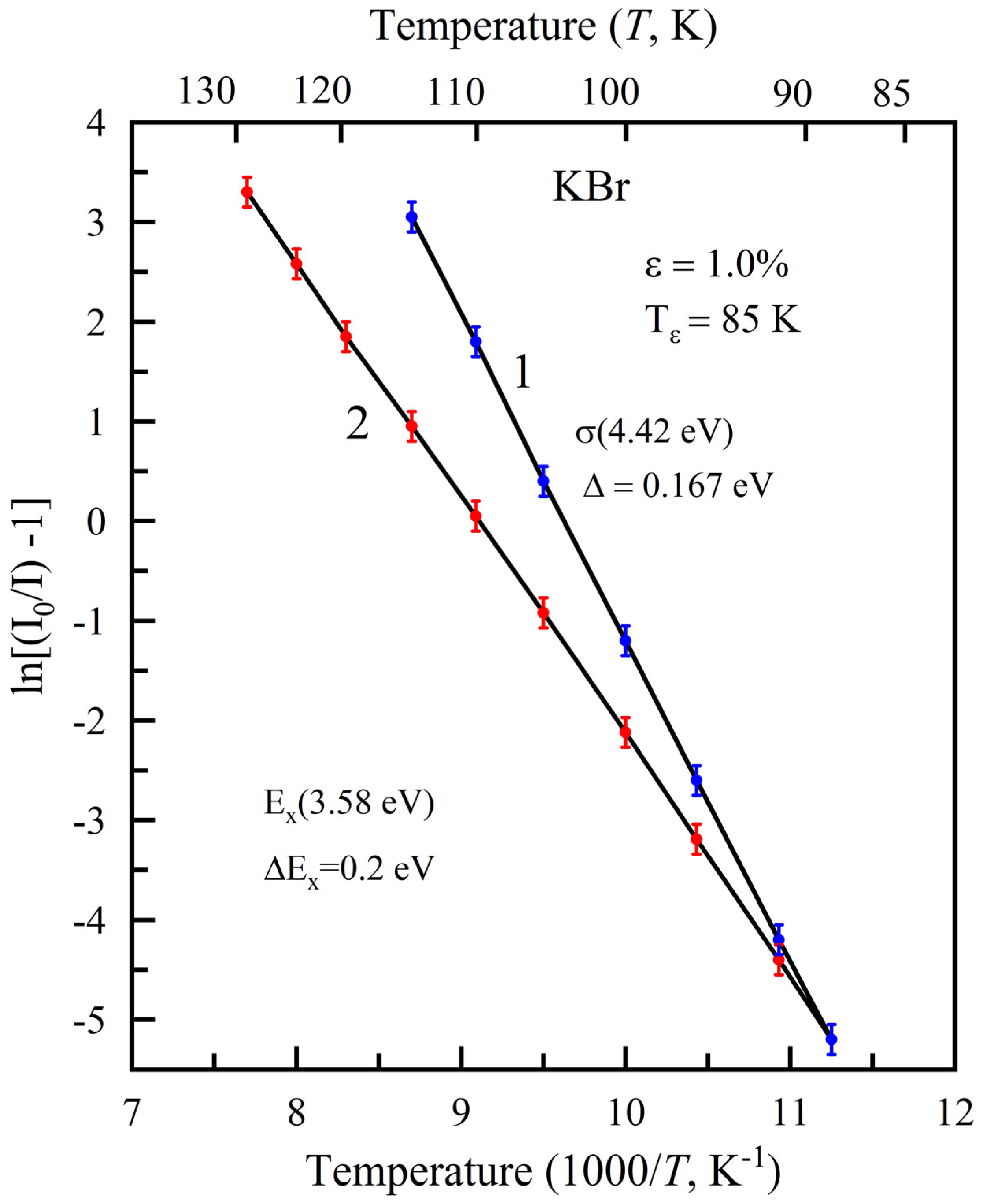
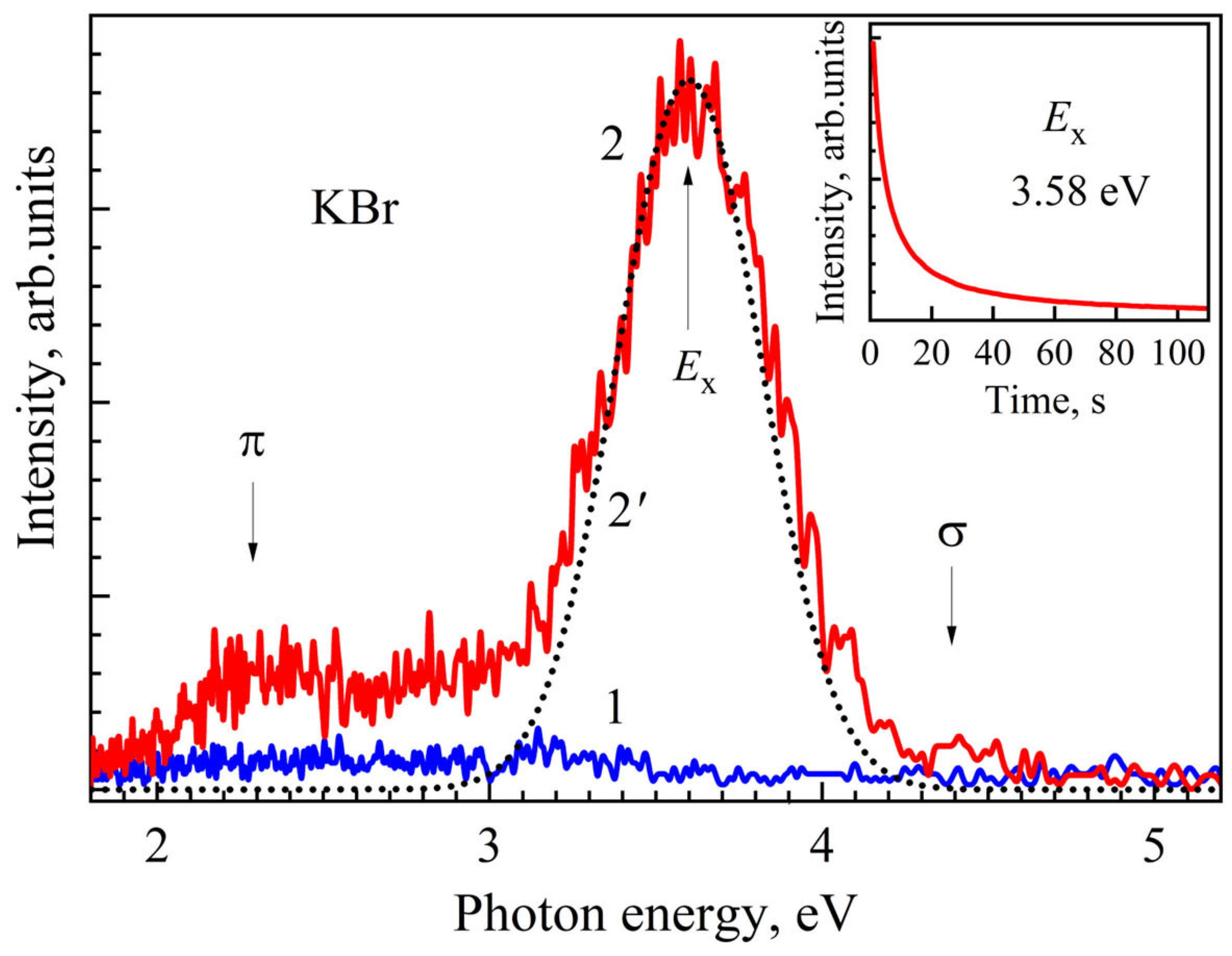
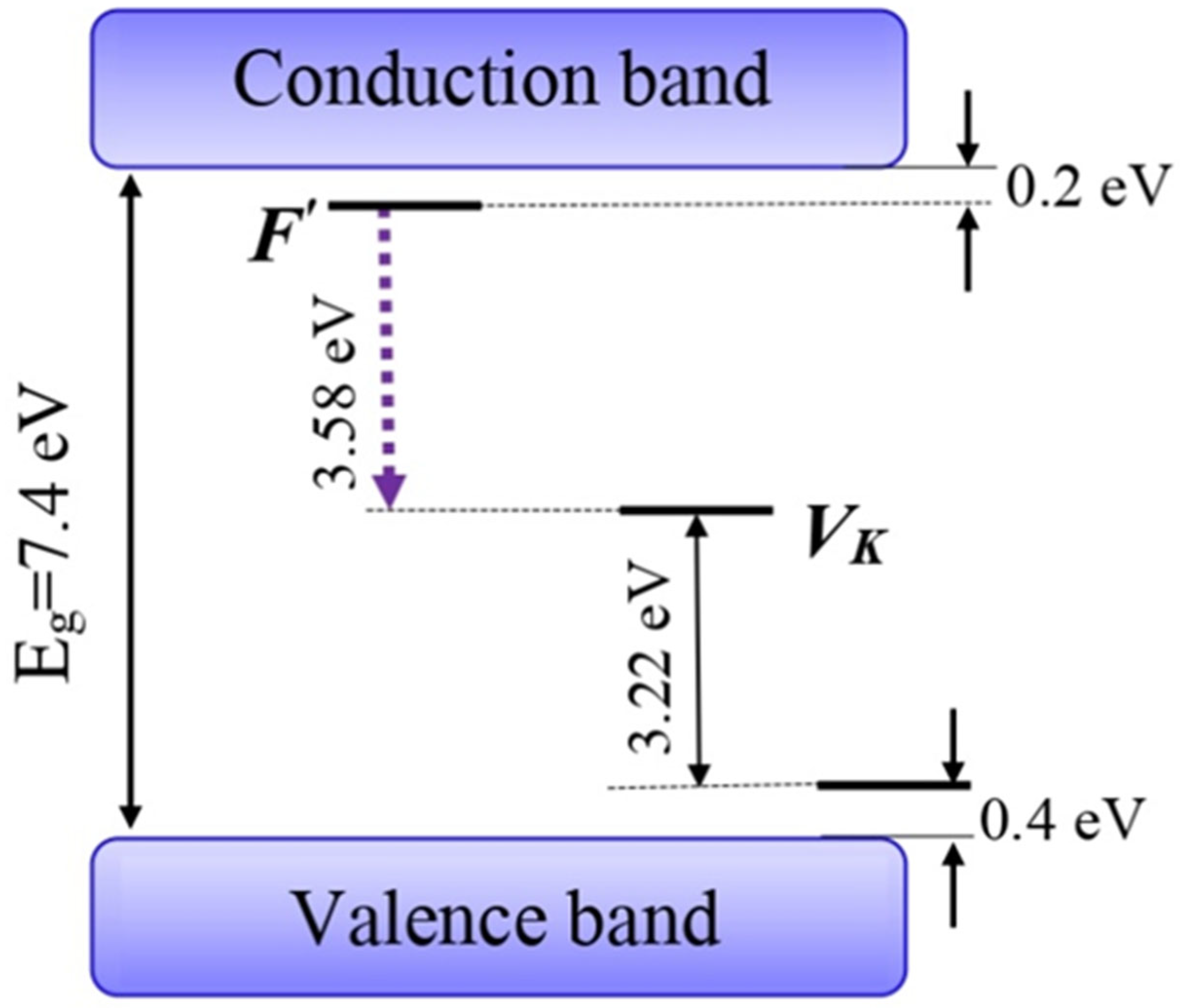
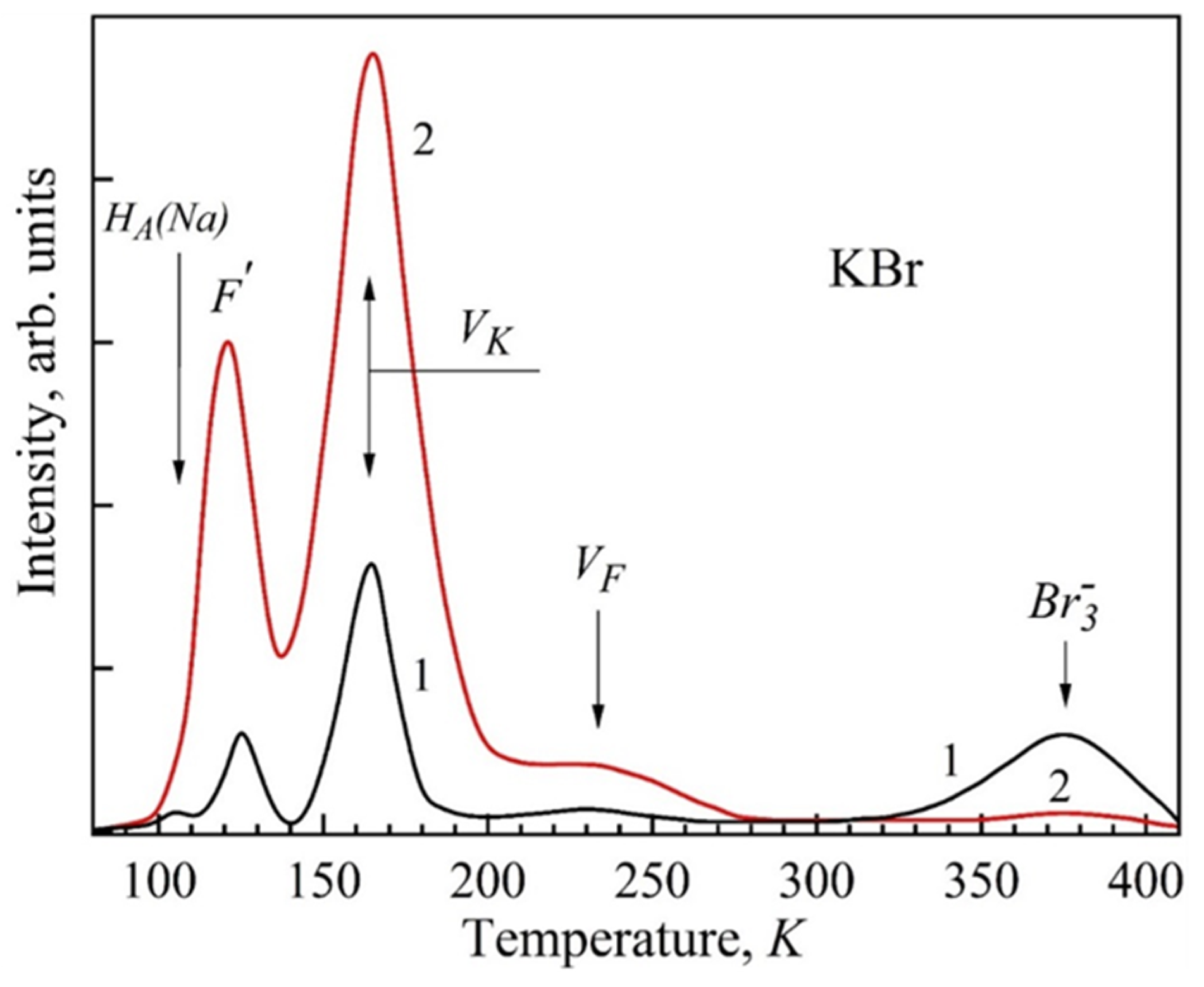
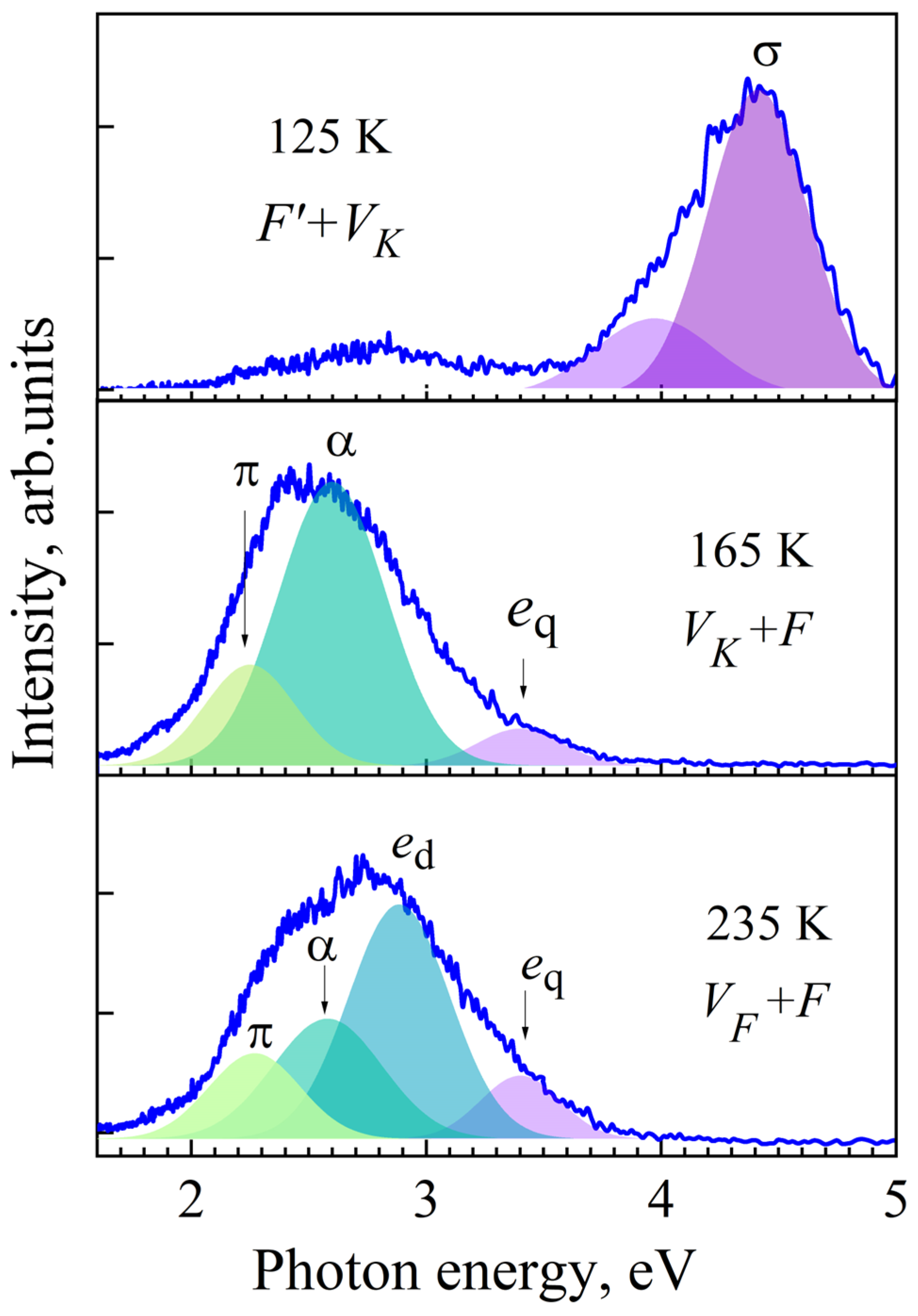

| Crystals | Eg (eV) | Maximum Optical Absorption VK-Center (eV) | Thermal Dissociation Energy VK-Center (eV) | Thermal Dissociation Energy F’-Center (eV) | Maximum Ex-Tunnel Luminescence (F’-, VK-Centers) (eV) |
|---|---|---|---|---|---|
| KBr | 7.4 | 3.22 | 0.4 | 0.2 | 3.58 1 |
| KCl | 8.5 | 3.4 | 0.54 | 0.3 | 4.26 2 |
Disclaimer/Publisher’s Note: The statements, opinions and data contained in all publications are solely those of the individual author(s) and contributor(s) and not of MDPI and/or the editor(s). MDPI and/or the editor(s) disclaim responsibility for any injury to people or property resulting from any ideas, methods, instructions or products referred to in the content. |
© 2024 by the authors. Licensee MDPI, Basel, Switzerland. This article is an open access article distributed under the terms and conditions of the Creative Commons Attribution (CC BY) license (https://creativecommons.org/licenses/by/4.0/).
Share and Cite
Shunkeyev, K.; Sagimbayeva, S.; Ubaev, Z.; Kenzhebayeva, A. Mechanisms for Enhancing Luminescence Yield in KBr Crystals under the Influence of Low-Temperature Uniaxial Elastic Deformation. Crystals 2024, 14, 698. https://doi.org/10.3390/cryst14080698
Shunkeyev K, Sagimbayeva S, Ubaev Z, Kenzhebayeva A. Mechanisms for Enhancing Luminescence Yield in KBr Crystals under the Influence of Low-Temperature Uniaxial Elastic Deformation. Crystals. 2024; 14(8):698. https://doi.org/10.3390/cryst14080698
Chicago/Turabian StyleShunkeyev, Kuanyshbek, Shynar Sagimbayeva, Zhiger Ubaev, and Adelya Kenzhebayeva. 2024. "Mechanisms for Enhancing Luminescence Yield in KBr Crystals under the Influence of Low-Temperature Uniaxial Elastic Deformation" Crystals 14, no. 8: 698. https://doi.org/10.3390/cryst14080698






